Collection of materials relating to neuro-ophthalmology as part of the Neuro-Ophthalmology Virtual Education Library.
NOVEL: https://novel.utah.edu/
TO
- NOVEL158
Filters: Collection: "ehsl_novel_novel"
| Title | Creator | Description | Subject | ||
|---|---|---|---|---|---|
| 1 |
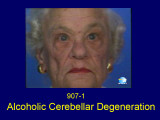 |
Alcoholic Cerebellar Degeneration | Shirley H. Wray, MD, PhD, FRCP | The patient is a 72 year old woman who presented with a 4 year history of progressive difficulty with balance, frequent falls and unsteadiness walking. She required a cane to steady herself. Past History: Significant for alcohol abuse. In 1980, she came to Boston for a second opinion and was seen in... | Square Wave Jerks; Dysmetria; Horizontal Saccadic Hypermetria; Horizontal Gaze Evoked Nystagmus; Saccadic Pursuit; Gait Ataxia; Alcoholic Cerebellar Degeneration; Gaze Evoked Horizontal Nystagmus; Horizontal Saccadic Dysmetria; Alcohol |
| 2 |
 |
Alcoholic Cerebellar Degeneration | Shirley H. Wray, MD, PhD, FRCP | Slideshow describing condition. | Alcoholic Cerebellar Degeneration; Dysmetria; Gait Ataxia; Gaze Evoked Horizontal Nystagmus; Horizontal Gaze Evoked Nystagmus; Horizontal Saccadic Dysmetria; Horizontal Saccadic Hypermetria; Saccadic Pursuit; Square Wave Jerks |
| 3 |
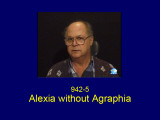 |
Alexia Without Agraphia | Shirley H. Wray, MD, PhD, FRCP | The patient is a 69 year old left handed man with a history of hypertension, insulin dependent diabetes mellitus and atrial fibrillation. Treated with coumadin, adjusted to keep the INR between 2 and 3. On the morning of admission he awoke at 4 a.m., sat momentarily on the side of the bed and then s... | Pure Alexia; Color Anomia; Right Homonymous Hemianopia; Alexia Without Agraphia; Infarct of the Left Visual Cortex and Splenium of the Corpus Callosum; Disconnection Syndrome; Occipital Infarct |
| 4 |
 |
Alexia Without Agraphia | Shirley H. Wray, MD, PhD, FRCP | Slideshow describing condition. | Alexia without Agraphia; Color Anomia; Disconnection Syndrome; Infarct of the Left Visual Cortex and Splenium of the Corpus Callosum; Pure Alexia; Right Homonymous Hemianopia |
| 5 |
 |
Alzheimer' s Disease | Shirley H. Wray, MD, PhD, FRCP | The patient is a 78 year old left handed woman with a diagnosis of a left parietal infarct in 1995, bilateral carotid artery stenosis and hypertension. She was first seen in August 1997 for evaluation of involuntary movements of the lower face in the setting of rapidly progressive dementia and was a... | Cerebral Cortex; Selective Saccadic Palsy - Acquired; Slow Initiation of Horizontal Saccades on Command; Slow Hypometric Horizontal Saccades; Supranuclear Saccadic and Pursuit Upgaze palsy; Slow Initiation of Horizontal Purusit Tracking a Slow Target; Positive Glabella Tap; Facial Tremor; Alzheimer'... |
| 6 |
 |
Alzheimer's Disease | Shirley H. Wray, MD, PhD, FRCP | Slideshow describing condition. | Alzheimer's Disease; Cerebral Cortex; CNS Degeneration; Facial Tremor; Positive Glabella Tap; Selective Saccadic Palsy - Acquired; Slow Hypometric Horizontal Saccades; Horizontal Purusit; Slow Initiation of Horizontal Saccades on Command; Supranuclear Saccadic and Pursuit Upgaze Palsy |
| 7 |
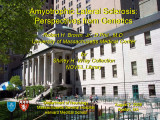 |
Amyotrophic Lateral Sclerosis | Robert H. Brown Jr, D.Phil, MD | Slideshow describing condition. | Bulbar Palsy; CNS Degeneration; Convergence Insufficiency; Familial Amyotrophic Lateral Sclerosis; Lou Gehrig's Disease; Saccadic Breakdown of Horizontal Pursuit; Slow Hypometric Horizontal Saccades; Superoxide Dismutase (SOD1) Gene; Supranuclear Paralysis of Up and Downgaze Degeneration |
| 8 |
 |
Amyotrophic Lateral Sclerosis (Guest Lecture) | John Q. Trojanowski, MD | The patient is a 68 year old right handed retired air conditioner repair man who presented with impaired balance and slow walking. For about one year he had noted difficulty lifting his feet high enough when climbing the stairs. From that time on, his movements slowed and worsened so that he had dif... | Saccadic Initiation Deficit of Unilateral Horizontal Gaze; Complete Paralysis of Voluntary Horizontal Saccades on Command to Look Left; Inability to Make a Refixation Saccade on Command to a Target Held on the Left; Normal Voluntary Horizontal Saccadic Eye Movements to the Right; Impaired Pursuit; F... |
| 9 |
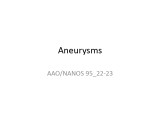 |
Aneurysms | AAO/NANOS - American Academy of Ophthalmology / North American Neuro-Ophthalmology Society | Aneurisms may result in neuro-ophthalmologic sign and symptoms by direct compression of the afferent or efferent systems or by the secondary effects of hemorrhage. Basilar aneurisms may result in ocular motor deficits such as a unilateral or bilateral third nerve palsy. | Aneurysm |
| 10 |
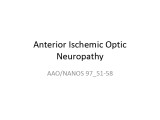 |
Anterior Ischemic Optic Neuropathy (PowerPoint) | AAO/NANOS - American Academy of Ophthalmology / North American Neuro-Ophthalmology Society | The patient is a 62-year-old female who presented in August 1996 with visual loss OD that she first noted as loss of her superior field in May 1996. She felt that it had been static since, and perhaps was even a little better in the week before she was seen. There was no pain, even with ocular rotat... | Nonarteritic Ischemic Optic Neuropathy ; Anterior Ischemic Optic Neuropathy |
| 11 |
 |
Anterior Ischemic Optic Neuropathy (Thai) | NANOS | Loss of blood supply to the optic nerve results in diminished visual acuity. | Anterior Ischemic Optic Neuropathy; AION; Patient Brochure |
| 12 |
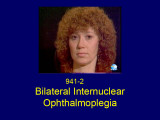 |
Bilateral Internuclear Ophthalmoplegia | Shirley H. Wray, MD, PhD, FRCP | This patient was seen at the Yale Eye Center at the age of 37. She had a long history of multiple sclerosis. At age 22, she had an acute attack of optic neuritis in the left eye which recovered fully within three weeks. Some months later she had a recurrent episode in the same eye, which also recove... | Bilateral Internuclear Ophthalmoplegia; Pendular Horizontal Oscillations; Lid Nystagmus; Upbeat Nystagmus; Botulinum Toxin Therapy; Multiple Sclerosis; Horizontal Pendular Nystagmus; Gaze Evoked Upbeat Nystagmus; Abducting Nystagmus |
| 13 |
 |
Bilateral Internuclear Ophthalmoplegia | Shirley H. Wray, MD, PhD, FRCP | Slideshow describing condition. | Abducting Nystagmus; Bilateral Internuclear Ophthalmoplegia; Botulinum Toxin Therapy; Gaze Evoked Upbeat Nystagmus; Horizontal Pendular Nystagmus; Lid Nystagmus; Multiple Sclerosis; Pendular Horizontal Oscillations; Upbeat Nystagmus |
| 14 |
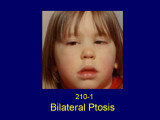 |
Bilateral Ptosis | Shirley H. Wray, MD, PhD, FRCP | A PowerPoint slideshow of diagnosed patients. | Bilateral Ptosis; Facial Weakness; Full Eye Movements; MuSK Antibody Myasthenia Gravis; Tongue Atrophy; Myasthenia Gravis |
| 15 |
 |
Bilateral Ptosis | Shirley H. Wray, MD, PhD, FRCP | This case, previously reported in 2007, is published courtesy of John Newsom-Davis, M.D., FRCP, FRS, CBE. Weatherall Institute of Molecular Medicine, John Radcliffe Hospital, Oxford. This patient was unusual in presenting in early childhood and the development of persistent facial muscle and tongue ... | Bilateral Ptosis; Full Eye Movements; Facial Weakness; Tongue Atrophy; MuSK Antibody Myasthenia Gravis |
| 16 |
 |
Blepharospasm Round Up | Shirley H. Wray, MD, PhD, FRCP | Slideshow describing condition. | Benign Essential Blepharospasm; Focal Dystonia; Lid Twitch; Psychogenic Blepharospasm; Voluntary Blinking |
| 17 |
 |
Blepharospasm Round-Up (Guest Lecture) | Shirley H. Wray, MD, PhD, FRCP | The patient is a 60 year old estate manager with a history of retinal laser therapy, dry eyes and age related bilateral ptosis. He carries a diagnosis of hilar lymphadenopathy due to sarcoid and has had cancer of the kidney. He presented in 1995 with a 6 month history of frequent blinking and spasms... | Benign Essential Blepharospasm; Focal Dystonia; Blepharospasm |
| 18 |
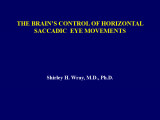 |
Brain Control of Horizontal Saccadic Eye Movements | Shirley H. Wray, MD, PhD, FRCP | PowerPoint lecture describing brain control of horizontal saccadic eye movements. | Acquired Ocular Motor Apraxia; Alzheimer's Disease with Mild Extrayramidal Signs; Cerebral Cortex; CNS Degeneration; Complete Paralysis of Voluntary Horizontal Saccades on Command to Look Left; Facial Tremor; Frontotemporal Dementia; Impaired Pursuit; Inability to Make a Refixation Saccade on Comma... |
| 19 |
 |
Brain Control of Horizontal Saccadic Eye Movements (Guest Lecture) | Shirley H. Wray, MD, PhD, FRCP | In 1995 I published this case alongside eleven personal cases, three with the Kearns-Sayer Syndrome (KSS) and five with Progressive External Opthalmoplegia (PEO). Am J of Neuroradiol:16 (5);1167-1173. The patient was under the care of Dr. Raymond Adams from age 13 years. In 1991, at age 40 years, I ... | Bilateral Ptosis; Facial Weakness; Complete External Ophthalmoplegia; Bilateral Progressive External Ophthalmoplegia (PEO); Mitochondrial Myopathy; PEO plus Deafness; Cerebellar Degeneration with Ataxia; Chronic Progressive External Opthalmoplegia |
| 20 |
 |
Brain MRI in Multiple Sclerosis | Anne G. Osborn, MD | Slideshow describing condition. | Abducting Nystagmus; Bilateral Internuclear Ophthalmoplegia; Botulinum Toxin Therapy; Gaze Evoked Downbeat Nystagmus; Horizontal Pendular Nystagmus; Horizontal Saccadic Dysmetria; Lid Nystagmus; Multiple Sclerosis; Normal Convergence; Oscillopsia; Pendular Horizontal Oscillations; Saccadic Dysmetri... |
| 21 |
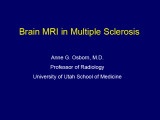 |
Brain MRI in Multiple Sclerosis (Guest Lecture) | Anne G. Osborn, MD | The patient is a 25 year old woman who was in excellent health until 4 days prior to admission when she noted blurred vision and horizontal double vision on lateral gaze to right and left. Past History: Negative for strabismus as a child. No previous episodes of transient neurological symptoms. Fami... | Bilateral Internuclear Ophthalmoplegia; Abducting Nystagmus; Normal Convergence; Gaze Evoked Upbeat Nystagmus; Gaze Evoked Downbeat Nystagmus; Saccadic Dysmetria; Multiple Sclerosis; Horizontal Saccadic Dysmetria |
| 22 |
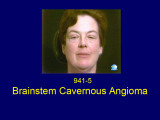 |
Brainstem Cavernous Angioma | Shirley H. Wray, MD, PhD, FRCP | Slideshow describing condition. | Bilateral Horizontal Gaze Palsy Hemorrhage; Bilateral Lid Nystagmus; Cavernous Angioma; Hiccup; Horizontal Gaze Evoked Nystagmus; Lid Nystagmus; Medulla Hemorrhage; Medullary Hemorrhage; Primary Position Upbeat Nystagmus; Upbeat Nystagmus |
| 23 |
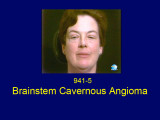 |
Brainstem Cavernous Angioma | Shirley H. Wray, MD, PhD, FRCP | The patient is a 50 year old woman who presented in November 1977 with a transient facial droop, nystagmus, diplopia, dysarthria and vertigo. She was admitted to New England Tufts Medical Center and had an extensive workup including an electroencephalogram, first generation CT brain scan, angiogram ... | Upbeat Nystagmus; Lid Nystagmus; Horizontal Gaze Evoked Nystagmus; Hiccup; Medullary Hemorrhage; Cavernous Angioma; Bilateral Lid Nystagmus; Bilateral Horizontal Gaze Palsy Hemorrhage; Primary Position Upbeat Nystagmus; Medulla Hemorrhage; Medulla |
| 24 |
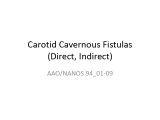 |
Carotid Cavernous Fistulas (PowerPoint) | AAO/NANOS - American Academy of Ophthalmology / North American Neuro-Ophthalmology Society | This 76-year-old woman has a 7-month history of redness and pressure sensation in both eyes that is worse in the morning. She has noted intermittent horizontal diplopia during this time. Angiography demonstrated a right dural cavernous sinus fistula, which was successfully occluded with direct injec... | Dural Arteriovenous Malformation; Carotid Cavernous Fistulas |
| 25 |
 |
Cavernous Angioma | Shirley H. Wray, MD, PhD, FRCP | Slideshow describing condition. | Cavernous Angioma; Convergence Normal; Facial Palsy; Fisher's One-and-a-Half Syndrome; Pendular Vertical Oscillations; Pontine Hemorrhage; Unilateral Gaze Palsy Hemorrhage; Unilateral Horizontal Gaze Palsy; Unilateral Internuclear Ophthalmoplegia; Upbeat Nystagmus on Upgaze |
